Overview
Welcome to Giving and Receiving Feedback Effectively!
Grading has multiple purposes: assessment and evaluation of student work; communication about student learning; source of motivation for continued learning.
In this workshop, you will learn about and consider ways to achieve these purposes with best practices for marking student assessments, including lab reports, problem sets, and essays.
Intended Learning Outcomes
By the end of this workshop, you should be able to:
- Explain the purpose of rubrics and other assessment tools
- Describe methods for marking efficiently, objectively, and consistently
- Identify strategies for providing constructive feedback to students
- Recognize challenges and considerations unique to marking in online contexts
- Predict possible issues in grading and ways to address them
References
Walvoord, B. E. F., & Anderson, V. J. (1998). Effective grading : a tool for learning and assessment (1st ed.). Jossey-Bass.
Reflecting on Your Marking
Activity 1
Before you begin to learn about what adjustments you can make for a more efficient and marking practice, it’s helpful to understand your current marking practice.
Complete this scenario activity and consider the reflection questions below.
Scenario
You have 30 short-answer responses to mark and you have set a goal to spend 1.5 hours to grade this assignment. This means that you have 3 minutes to mark each paragraph (90 minutes / 30 assignments).
The question students were asked to answer is as follows:
“Explain what we can do as citizens to reduce the effects of global warming. Consider factors such as recycling, the impact of fossil fuels, and the impact of consumerism.”
Instructions
- Set a timer for three minutes.
- Mark the following paragraph and assign it a mark out of ten (/10) within that time limit.
- Complete the reflection questions below.
Reflection Questions
- Were you able to finish marking and assign a grade within 3 minutes? Did it feel rushed, or was it a comfortable amount of time? Would you be able to keep up this pace for another 29 assignments?
- How did you decide what mark to assign the paragraph? What strengths and/or weaknesses in the response influenced this decision?
Constructive Alignment and Rubrics
How do we ensure we’re supporting student learning when marking? This section discusses the purpose of rubrics and other assessment tools in relation to course intended learning outcomes.
The Relationship Between Constructive Alignment and Rubrics
How do we ensure we’re supporting student learning when marking? This video looks at the purpose of rubrics and other assessment tools in relation to course intended learning outcomes.
Reflection Question
Think back to completing Activity 1 and the sample assignment you graded and answer the two reflective questions in this ungraded quiz.
- What skills or content could the sample assignment have been intended to assess?
- How would knowing the associated intended learning outcome (ILO) guide your evaluation of the sample assignment?
Fair Grading
How do we ensure our grading is fair? This section covers strategies and best practices for marking efficiently, objectively, and consistently with any type of assessment.
Sample Marking Scenario
Think back to the example scenario presented in Activity 1:
You have 30 short-answer responses to mark. You have been allotted an hour and a half for grading this assignment, which anticipates 3 minutes will be spent on each paragraph.
How do we make sure we evaluate each paragraph in the same way while staying within the suggested time?
This video addresses strategies we can use in our marking practice to meet these goals.
Marking Efficiently and Effectively: Feedback
How do we provide feedback that will be useful for and beneficial to students? Here, we will consider ways to mark constructively – as in, ways that will help students improve their knowledge and skills.
The Dialogic Feedback Cycle
Providing feedback on an assignment is one of three key pieces to helping students learn and improve through completing assessments as part of the Dialogic Feedback Cycle outlined by Beaumont et al (2011).
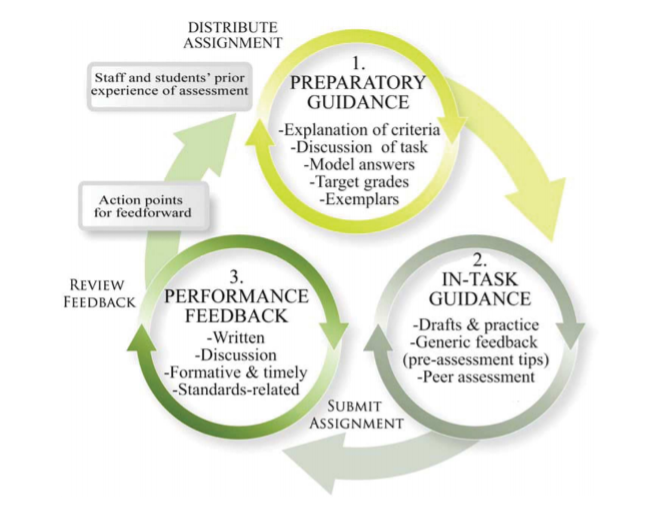
The first step is providing Preparatory Guidance, which happens before students begin an assessment. This includes explaining the assignment requirements, introducing students to the rubric that will be used to assess their work, providing models and examples, and answering their questions.
The second step is providing In-Task Guidance, which happens as students are completing or preparing for the assessment. This can include feedback on drafts – if feasible, which time constraints can make challenging – or self-assessed practice assessments, peer evaluation, and general tips.
Finally, the third step is providing Performative Feedback, after students have completed the assessment. This feedback should not only show students where they have done well or poorly on this specific assignment, but it should also provide them with specific advice for how to perform better on future assessments.
The Purpose of Feedback
Consider what purpose you would like the feedback you provide to serve. One way to do this is to complete the following before you begin grading:
After reading my feedback, I want students to be able to…
While a general statement is important, you might also consider completing this statement for individual students based on their current achievement level and their most significant opportunities for growth and improvement.
Feedback Samples
Below are four feedback samples. As you review each of these samples, think about the following questions:
- What is your immediate reaction to the feedback?
- As a learner, what information would the feedback give you?
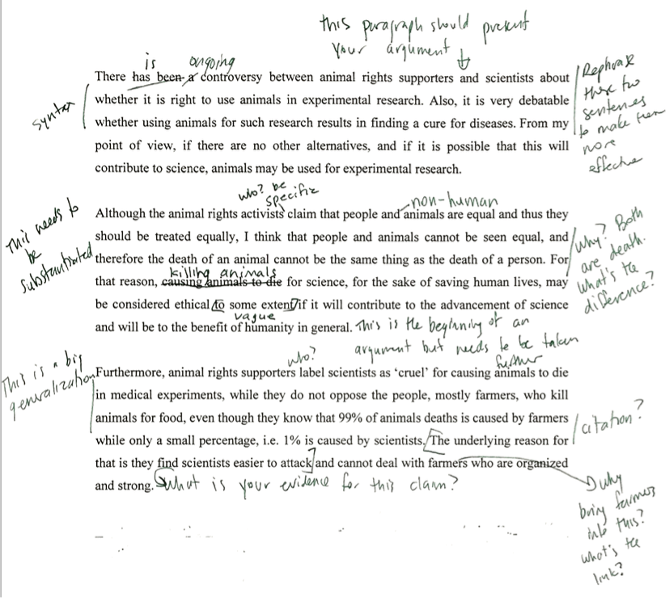
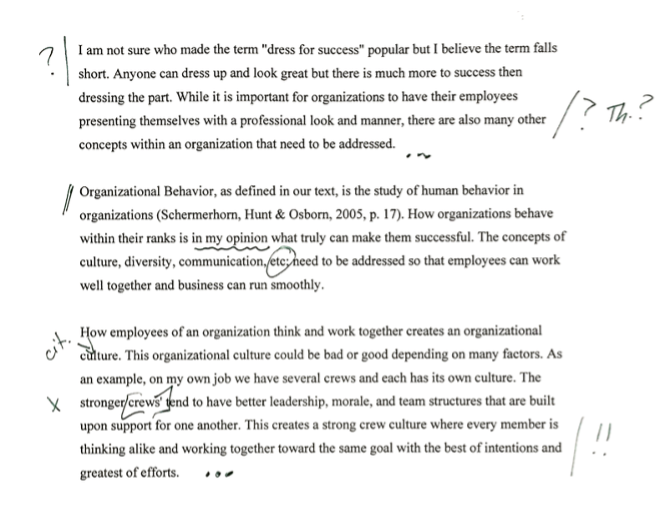
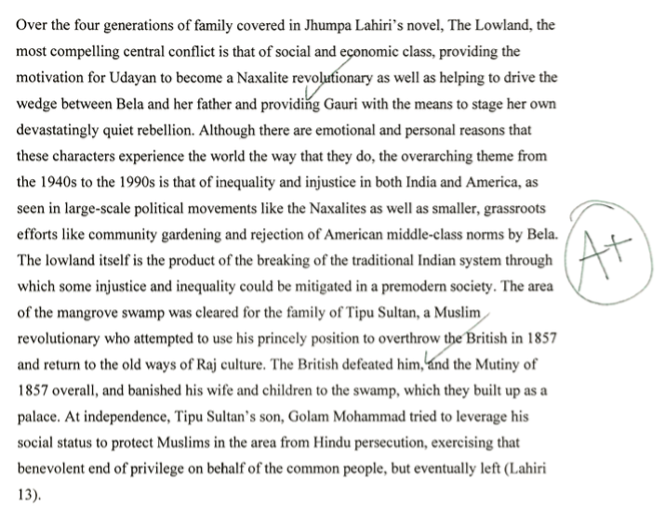
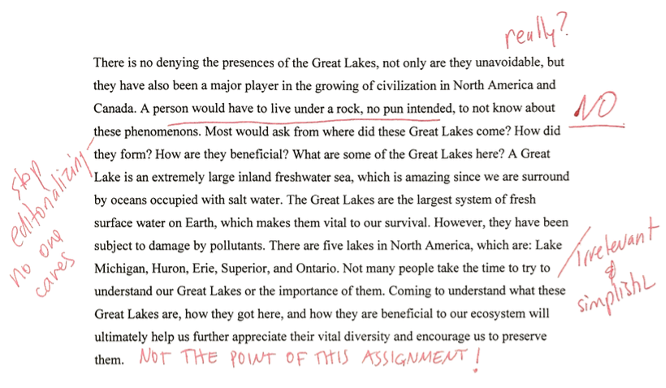
Common Issues
Each of the feedback samples provided demonstrated a common issue:
- There was too much feedback to effectively take in.
- The shorthand was not explained, and therefore could not be understood.
- There was no indication of specific strengths or areas for further improvement.
- The feedback did not demonstrate respect for the student or provide specific advice for improvement.
So, what does quality feedback look like?
Quality Feedback
Quality feedback meets three criteria:
To help ensure you feedback can be understood, be as specific as possible. Draw students’ attention to specific examples of strengths and weaknesses, and explain which criteria they did or did not meet and how.
Use words and phrases students will know. This includes avoiding – or explaining – any disciplinary terms or jargon. If you’re going to use any shorthand, make sure students know this and have a legend or key available to remind them what the markings mean.
It can be hard to take in a lot of feedback, particularly if it includes comments on weaknesses or areas for improvement. Pure criticism is hard to work through, and students might miss recognizing what they are doing well. To help ensure your feedback can be accepted by students so they can learn from it, limit your feedback to a few key points, and be as positive as possible – help them recognize their strengths, as well, and phrase your comments so they talk about “the assessment” and not “you,” the student. Remember that your comments are “notes to people” as well as “reflections on an assessment.”
Students are very rarely going to write an essay on the same topic twice, or complete the same problem set or lab more than one. For feedback to be useful in helping students to improve, it needs to be about the process of completing the assessment over the specific content. Think about criteria that will always apply to that type of assessment and help students recognize areas for improvement that will apply next time, too.
Feedback that provides concrete suggestions for developing skills and improving student work is called “learner-centred.” It should provide students with a clear goal to work towards and specific actions to take in order to achieve it.
Recognizing that students will probably never complete the same assessment again, you can also ask students to respond to the feedback they receive to help them draw general lessons that will be applicable in the future. This is especially valuable to do with final assessments in a course, since feedback is most useful if it can be acted on quickly, and it will likely be some time before students attempt a similar assessment again. You might ask students to write out a brief strategy for how they’ll approach the next assessment or what they will focus on improving, and encourage them to review it next time they have a similar assessment to complete. This can also help you confirm that students have understood the feedback they received.
Feedback Strategies
This strategy involves limiting your feedback to three key points:
- First, comment on the strongest aspect of the assessment, or the best-met criteria.
- Then, address the weakest aspect of the assessment, or the criteria which needs the most improvement.
- Finally, end by highlighting an aspect which could be quickly improved.
This is an explicitly learner-centred strategy where you focus your feedback on identifying what would make the biggest improvement in a student’s work: written communication skills, content knowledge, following criteria, etc. Your feedback should highlight this for students and identify concrete steps they can take to address this need, such as seeking help with punctuation through the Student Success Centre’s writing tutors or reviewing the rubric before submitting. This strategy meets each student where they are and helps them improve their individual areas of need (Lizzio and Wilson, 2008).
Summary
Let’s return to the question we posed at the start of this section: How do we provide feedback that will be useful for and beneficial to students?
We can now provide the following answers:
- Consider what you want students to be able to do or improve as a result of your feedback
- Give comments that can be understood, accepted, and acted on
- Use positive and learner-centred feedback strategies
- Feedback Sandwich
- Next Step
Activity 2 – Sample Grading Activity Revisited
We are going to revisit the scenario and re-evaluate the sample assignment from the first worksheet. As a reminder, here is the scenario:
Scenario
You have 30 short-answer responses to mark and you have set a goal to spend 1.5 hours to grade this assignment. This means that you have 3 minutes to mark each paragraph (90 minutes / 30 assignments).
The question students were asked to answer is as follows:
“Explain what we can do as citizens to reduce the effects of global warming. Consider factors such as recycling, the impact of fossil fuels, and the impact of consumerism.”
Instructions
- This time, before you set the timer, answer the following question for yourself:
- What is the assignment intended to assess? For instance, you might decide it is assessing their writing skill, their content knowledge, or both.
- Set a timer for three minutes. Re-read the paragraph, noting relevant strengths and weaknesses. Assign a new grade out of ten (/10) and provide feedback for the student. Try to complete this within the time limit.
- Complete the reflection questions below.
Reflection Questions
- What was different about marking the sample this time? What was easier? Harder?
- Were you able to finish marking and assign a grade within 3 minutes? Did it feel rushed, or was it a comfortable amount of time? Would you be able to keep up this pace for another 29 assignments?
- How did you decide what mark to assign the paragraph? What strengths and/or weaknesses in the response influenced this decision?
- Do you feel that the feedback you provided will help the student develop their skills and/or knowledge? Would it help them improve their grade if they were to submit this assignment again?
Marking Online
How do we apply these principles and practices for online courses?
This section highlights considerations and available tools for marking, providing feedback, and submitting grades online, focusing on Avenue to Learn.
Avenue to Learn: Rubrics
Avenue to Learn: Assignments
There are Annotation Tools that can be enabled within Avenue to Learn by ticking the box for “Make annotation tools available for assessment” (found at the bottom of the page) when creating or editing an assignment submission folder. With these tools enabled, you can highlight text, draw, and leave comments in various formats on documents submitted by students within the evaluation screen. It is important to note, however, that these annotations are not fully accessible and cause issues with some screen readers.
Avenue to Learn: Grades
Summary
Let’s return to the question we posed at the start of this section: How do we apply these principles and practices for online courses?
We can now provide the following answers:
- Keep records and back-up copies of your grading
- Maintain confidentiality and security with respect to student work
- Use, adapt, and adopt new strategies for ensuring your marking is effective, efficient, objective, consistent, and constructive
- As appropriate, and with instructor consent, make use of Avenue to Learn’s features
- Rubrics
- Assignments
- Grades
Marking Efficiently and Effectively Module Summary
The Importance of Communication
It is difficult to overstate the importance of communication in good grading practice. Before, during, and after grading an assessment, you should be in contact with:
Co-instructors and TAs, about
- assessment criteria and grading schemes,
- rubrics and other tools you may be using,
- relevant course policies (late assessments, over or under length, academic dishonesty),
- their expectations (for feedback, reviewing graded assessments, anticipated average grades, deadlines)
The students, about
- assessment instructions and requirements,
- samples or models they can use,
- frequent challenges or issues,
- available supports (e.g., Student Success Centre)
- university and course policies
- appeal processes
Summary
This brings us to the end of the workshop. Throughout this workshop, we considered ways to mark:
- Effectively
- Efficiently
- Objectively
- Consistently
- Constructively
- Virtually
Information Box Group
Module Reflection Form Microsoft Form
Congratulations on completing a module in the MacPherson Institute Learning Catalogue!
We hope you found the experience meaningful and relevant to your teaching and learning practice. As part of our ongoing effort to improve and grow the Learning Catalogue, we invite you to take just a few minutes to complete a short reflection form.
We know your time is valuable, and we deeply appreciate your willingness to share your thoughts.
References
Beaumont, C., O’Doherty, M., & Shannon, L. (2011). Reconceptualising assessment feedback: a key to improving student learning? Studies in Higher Education, 36(6), 671-687.
Carless, D. et al. (2011). Developing sustainable feedback practices. Studies in Higher Education, 36(4), 395-407.
Higgins, R., Hartley, P., & Skelton, A. (2002). The conscientious consumer: reconsidering the role of assessment feedback in student learning. Studies in Higher Education, 27(1), 53-64.
Lizzio, A., & Wilson, K. (2008). Feedback on assessment: students’ perceptions of quality and effectiveness. Assessment & Evaluation in Higher Education, 33(3), 263-275.
Nicol, D.J., & Macfarlane-Dick, D. (2006) Formative assessment and self-regulated learning: a model and seven principles of good feedback practice. Studies in Higher Education, 31(2), 199-218.
Poulos, A. & Mahony, M.J. (2008). Effectiveness of feedback: the students’ perspective. Assessment & Evaluation in Higher Education, 33(2), 143-154.
Walvoord, B.E. & Anderson, V.J. (2011). Effective Grading: A Tool for Learning and Assessment in College, Second Edition, John Wiley & Sons.

